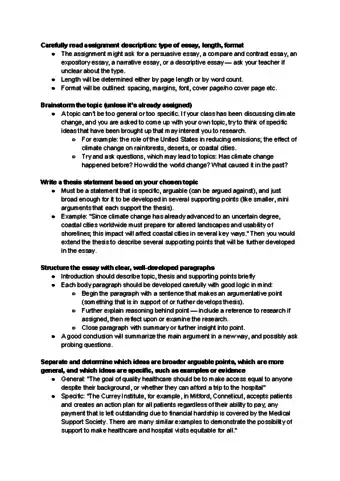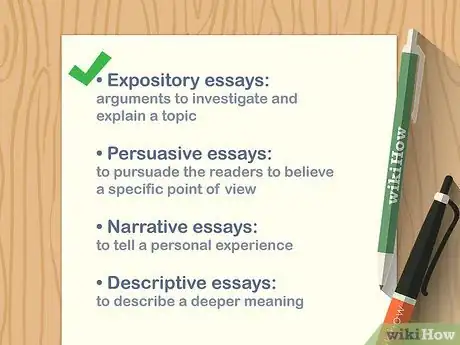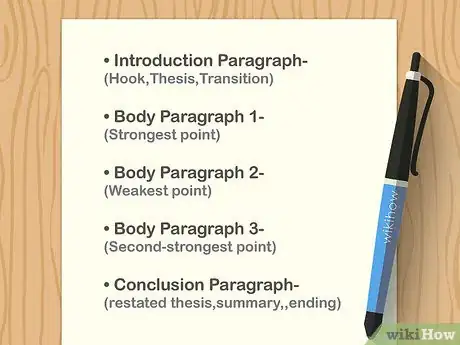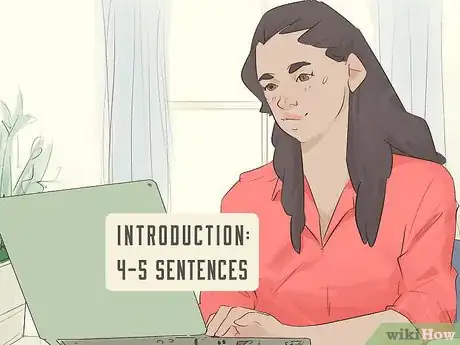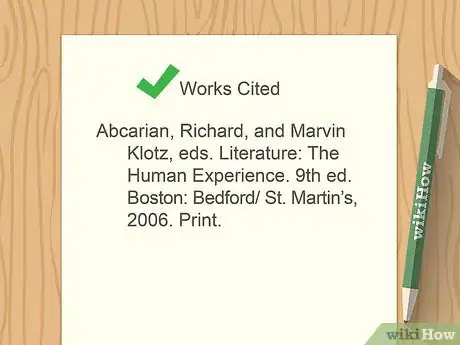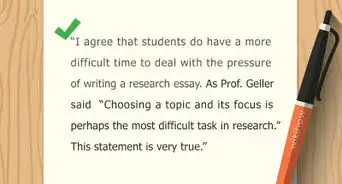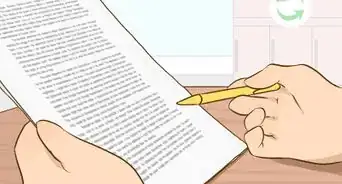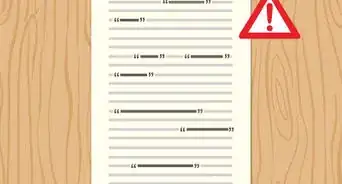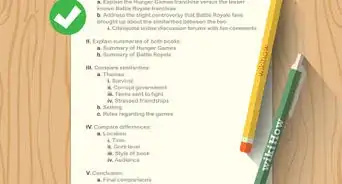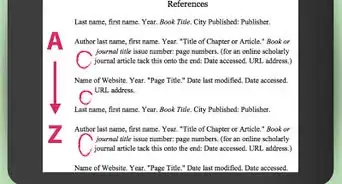This article was co-authored by Emily Listmann, MA and by wikiHow staff writer, Hunter Rising. Emily Listmann is a private tutor in San Carlos, California. She has worked as a Social Studies Teacher, Curriculum Coordinator, and an SAT Prep Teacher. She received her MA in Education from the Stanford Graduate School of Education in 2014.
There are 14 references cited in this article, which can be found at the bottom of the page.
This article has been viewed 547,887 times.
Writing an essay is an important basic skill that you will need to succeed in high school and college. While essays will vary depending on your teacher and the assignment, most essays will follow the same basic structure. By supporting your thesis with information in your body paragraphs, you can successfully write an essay for any course!
Steps
Writing Help
Planning Your Essay
-
1Determine the type of essay you need to write. Check the specific requirements for your essay provided by your teacher to see what type of essay you need to write. While the essays will differ in subject matter, they tend to follow the same 5 paragraph structure. Review what the assignment is asking you to complete so you know what sort of information you need to include.[1]
- Expository essays uses arguments to investigate and explain a topic.
- Persuasive essays try to convince the readers to believe or accept your specific point of view
- Narrative essays tell about a real-life personal experience.
- Descriptive essays are used to communicate deeper meaning through the use of descriptive words and sensory details.
-
2Do preliminary research on your essay’s topic. Start looking for general information and evidence on the topic you were assigned or chose. Try to find similarities or connections between the facts that you find. Organize and save the information so you can revisit it later. When you see relationships or points that work with one another, you’re able to work with them to develop your main argument for the essay.[2]
- Look through books or use search engines online to look at the broad topic before narrowing your ideas down into something more concise.
Advertisement -
3Create an arguable thesis statement if needed. The thesis statement is the point of view you present to the reader and the main focus of your entire essay. If you need to make an argument in your essay, write the argument in one clear and concise sentence. Make sure the point is arguable and not just a general thought or idea.[3]
- For example, the statement “Elephants are used to perform in circuses” does not offer an arguable point. Instead, you may try something like “Elephants should not be kept in the circus since they are mistreated.” This allows you to find supporting arguments or for others to argue against it.
- Keep in mind that some essay writing will not require an argument, such as a narrative essay. Instead, you might focus on a pivotal point in the story as your main claim.
-
4Find reliable sources that support your argument. Avoid using personal blogs or websites that are biased. Instead, look for scholarly articles, lab research, or general news sources for the most accurate information. Find books published by large publishers that support your arguments as well.[4]
- Talk to your school’s librarian for direction on specific books or databases you could use to find your information.
- Many schools offer access to online databases like EBSCO or JSTOR where you can find reliable information.
- Wikipedia is a great starting place for your research, but it can be edited by anyone in the world. Instead, look at the article’s references to find the sites where the information really came from.
- Use Google Scholar if you want to find peer-reviewed scholarly articles for your sources.
- Make sure to consider the author’s credibility when reviewing sources. If a source does not include the author’s name, then it might not be a good option.
-
5Make an outline for the paragraphs in your essay. Many essays will follow a 5-paragraph structure: an introductory paragraph, 3 body paragraphs, and a conclusion. When you have the information for your argument, organize the paragraphs so they flow logically from one to the other. Include at least 2-3 subpoints you want to include for the evidence or specific information from your research for each body paragraph.[5]
- Outlines will vary in size or length depending on how long your essay needs to be. Longer essays will have more body paragraphs to support your arguments.
Starting an Essay
-
1Hook the readers with a relevant fact, quote, or question for the first sentence. An attention getter draws readers into your essay. Use a shocking statistic or a hypothetical question to get the reader thinking on your subject. Make sure not to use an attention getter unrelated to the topic of your essay. Use your attention getter to help lead into your main argument.[6]
- Make sure your quotes or information are accurate and not an exaggeration of the truth, or else readers will question your validity throughout the rest of your essay.
-
2Introduce your thesis in one sentence. After your attention getter, state the purpose of your essay so the reader knows the main topic. Keep your thesis statement in a clear and concise statement so they know exactly what stance you’re taking on the subject.[7]
- For example, “Because global warming is causing the polar ice caps to melt, we need to eliminate our reliance on fossil fuels within the next 5 years.” Or, “Since flavored tobacco appeals mainly to children and teens, it should be illegal for tobacco manufacturers to sell these products.”
- The thesis is usually the last or second to last sentence in your introduction.
-
3Provide a sentence that’s a mini-outline for the topics that your essay covers. Write a sentence that briefly introduces what information you’re providing to support your thesis. This helps your reader know exactly what you’re discussing and what they should expect from the rest of your essays.[8]
- Use the main topics of your body paragraphs as an idea of what to include in your mini-outline.
-
4Keep the introduction between 4-5 sentences. Don’t summarize your entire essay in the introduction or provide too much background information. Save your important information for your body paragraphs. Think of your introductory paragraph as a simple lead-in for the rest of your paper.[9]
Writing the Body Paragraphs
-
1Start each paragraph with a topic sentence. The topic sentence states the main point of the paragraph and relates directly back to your thesis. When you write your other sentences, they need to support your topic sentence. Use your outline to help write your topic sentence for your body paragraphs.[10]
- Think of your topic sentences as mini-theses so your paragraphs only argue a specific point.
-
2Include evidence and quotes from your research and cite your sources. Use your research to summarize or include direct quotes from your sources to give your essay validity. When you include information that isn’t common knowledge, cite your sources in-text based on the format required for your paper.[11]
- Many high school essays are written in MLA or APA style. Ask your teacher what format they want you to follow if it’s not specified.
-
3Provide your own analysis of the evidence you find. Give relevance to the quotes of information you provide in your essay so your reader understands the point you are trying make. Don’t assume your reader will make the connection between your info and the thesis of your paper. Analysis also gives you a chance to include your own thoughts and interpretation of the facts you provide.
- Unless you’re writing a personal essay, avoid the use of “I” statements since this could make your essay look less professional.
-
4Use transitional phrases between each of your body paragraphs. To ensure that your readers can smoothly move between your body paragraphs, use words or phrases to relate the paragraphs to one another. This will make it so your essay doesn’t seem disjointed and will keep your points succinct.[12]
- For example, if your body paragraphs discuss similar points in a different way, you can use phrases like “in the same way,” “similarly,” and “just as” to start other body paragraphs.
- If you are posing different points, try phrases like “in spite of,” “in contrast,” or “however” to transition.
Concluding Your Essay
-
1Restate your thesis and summarize your arguments briefly. Remind the readers of the main focus of your essay and the arguments you posed. Don’t repeat your thesis word for word, but instead rephrase it along with your topic sentences. This helps the reader remember what you’ve discussed and it will stick with them for longer.[13]
- For example, if your thesis was, “The cell phone is the most important invention in the past 30 years,” then you may restate the thesis in your conclusion like, “Due to the ability to communicate anywhere in the world and access information easily, the cell phone is a pivotal invention in human history.”
- If you’re only writing a 1-page paper, restating your main ideas isn’t necessary.
-
2Discuss why the subject of your paper is relevant moving forward. Take the point of your essay and relate it to the real world and what information a reader can incorporate into their lives. This helps give reason to why you’ve written the essay that goes deeper than the prompt you’ve been given by your teacher.
- For example, if you write an essay discussing the themes of a book, think about how the themes are affecting people’s lives today.
-
3End the paragraph with a lasting thought that ties into your introduction. Close out your essay with another sentence that’s either a fact, question, or quote. Relate it back to your introduction so your essay comes full circle and leaves a sense of closure on the topic you’ve discussed.[14]
- Try to pick the same type of closing sentence as you used as your attention getter.
-
4Include a Works Cited page if you need one. Check with your teacher to see if they would like you to include a works cited and what format they prefer. Then, compile the sources you used on a separate page at the end of your essay. Organize your sources alphabetically by the authors’ last names. Make sure to follow the correct citation format depending on the style of essay you’ve written.[15]
- Including a Works Cited page shows that the information you provided isn’t all your own and allows the reader to visit the sources to see the raw information for themselves.
- Avoid using online citation machines since they may be outdated.
Revising the Paper
-
1Determine if your point comes across clearly through your arguments. Your essay should clearly define your argument and provide supporting examples. When you read your essay again, make sure it doesn’t read as confusing or contradict what you’re trying to argue.[16]
- Have a peer or parent read through your essay to see if they understand what point you’re trying to make.
-
2Check the flow of your essay between paragraphs. Look over your transitional statements and make sure your body paragraphs make sense leading into one another. On a sentence level, make sure your thoughts are cohesive and each sentence influences what you say in the next one. This helps a reader follow your train of thought better.
- For example, if your essay discusses the history of an event, make sure your sentences flow in a chronological way in the order the events happened.
-
3Rewrite or remove any sections that go off-topic. Make sure each of your sentences supports your thesis or your topic sentences. If you have any contradictions or information that doesn’t defend your argument, consider cutting it from your essay or finding a way to tie it into your main focus.
- If you cut parts out of your essay, make sure to reread it to see if it affects the flow of how it reads.
-
4Read through your essay for punctuation or spelling errors. Once you’ve edited your essay for content, look for sentence-level errors such as punctuation, word choice, and spelling. Read your essay out loud to hear any mistakes you may have glossed over.[17]
Community Q&A
-
QuestionApproximately how long will it take to write a 1600 word essay using APA style?
 Community Answer4-5 days depending on how long you work on it each day. If you concentrate it might only take you 3 days.
Community Answer4-5 days depending on how long you work on it each day. If you concentrate it might only take you 3 days. -
QuestionHow do I make a conclusion for my essay sound natural?
 Community AnswerTry adding a sentence that leaves the reader with a lingering thought.
Community AnswerTry adding a sentence that leaves the reader with a lingering thought. -
QuestionIf it's a mandatory essay and I'm really not into it what should I do?
 Community AnswerJust force yourself to write the essay. Because it's mandatory, it will be part of your mark. Give yourself plenty of time because it will likely take longer. But try to find something interesting about the topic to focus on.
Community AnswerJust force yourself to write the essay. Because it's mandatory, it will be part of your mark. Give yourself plenty of time because it will likely take longer. But try to find something interesting about the topic to focus on.
Warnings
- Avoid using plagiarism since this could result in academic consequences.⧼thumbs_response⧽
References
- ↑ https://www.grammarly.com/blog/types-of-essays/
- ↑ https://writingcenter.unc.edu/tips-and-tools/thesis-statements/
- ↑ https://writingcenter.unc.edu/tips-and-tools/thesis-statements/
- ↑ https://guides.libs.uga.edu/reliability
- ↑ https://facultyweb.ivcc.edu/rrambo/eng1001/outline.htm
- ↑ https://examples.yourdictionary.com/20-compelling-hook-examples-for-essays.html
- ↑ https://wts.indiana.edu/writing-guides/how-to-write-a-thesis-statement.html
- ↑ https://guidetogrammar.org/grammar/five_par.htm
- ↑ https://learning.hccs.edu/faculty/jason.laviolette/persuasive-essay-outline
- ↑ https://academicguides.waldenu.edu/writingcenter/paragraphs/topicsentences
- ↑ https://academicguides.waldenu.edu/writingcenter/paragraphs/topicsentences
- ↑ https://writingcenter.unc.edu/tips-and-tools/transitions/
- ↑ https://writingcenter.fas.harvard.edu/pages/ending-essay-conclusions
- ↑ https://libguides.newcastle.edu.au/how-to-write-an-essay/conclusion
- ↑ https://pitt.libguides.com/citationhelp
- ↑ https://writingcenter.unc.edu/tips-and-tools/revising-drafts/
- ↑ https://writingcenter.unc.edu/tips-and-tools/revising-drafts/
About This Article
Writing good essays is an important skill to have in high school, and you can write a good one by planning it out and organizing it well. Before you start, do some research on your topic so you can come up with a strong, specific thesis statement, which is essentially the main argument of your essay. For instance, your thesis might be something like, “Elephants should not be kept in the circus because they are mistreated.” Once you have your thesis, outline the paragraphs for your essay. You should have an introduction that includes your thesis, at least 3 body paragraphs that explain your main points, and a conclusion paragraph. Start each body paragraph with a topic sentence that states the main point of the paragraph. As you write your main points, make sure to include evidence and quotes from your research to back it up. To learn how to revise your paper, read more from our Writing co-author!
